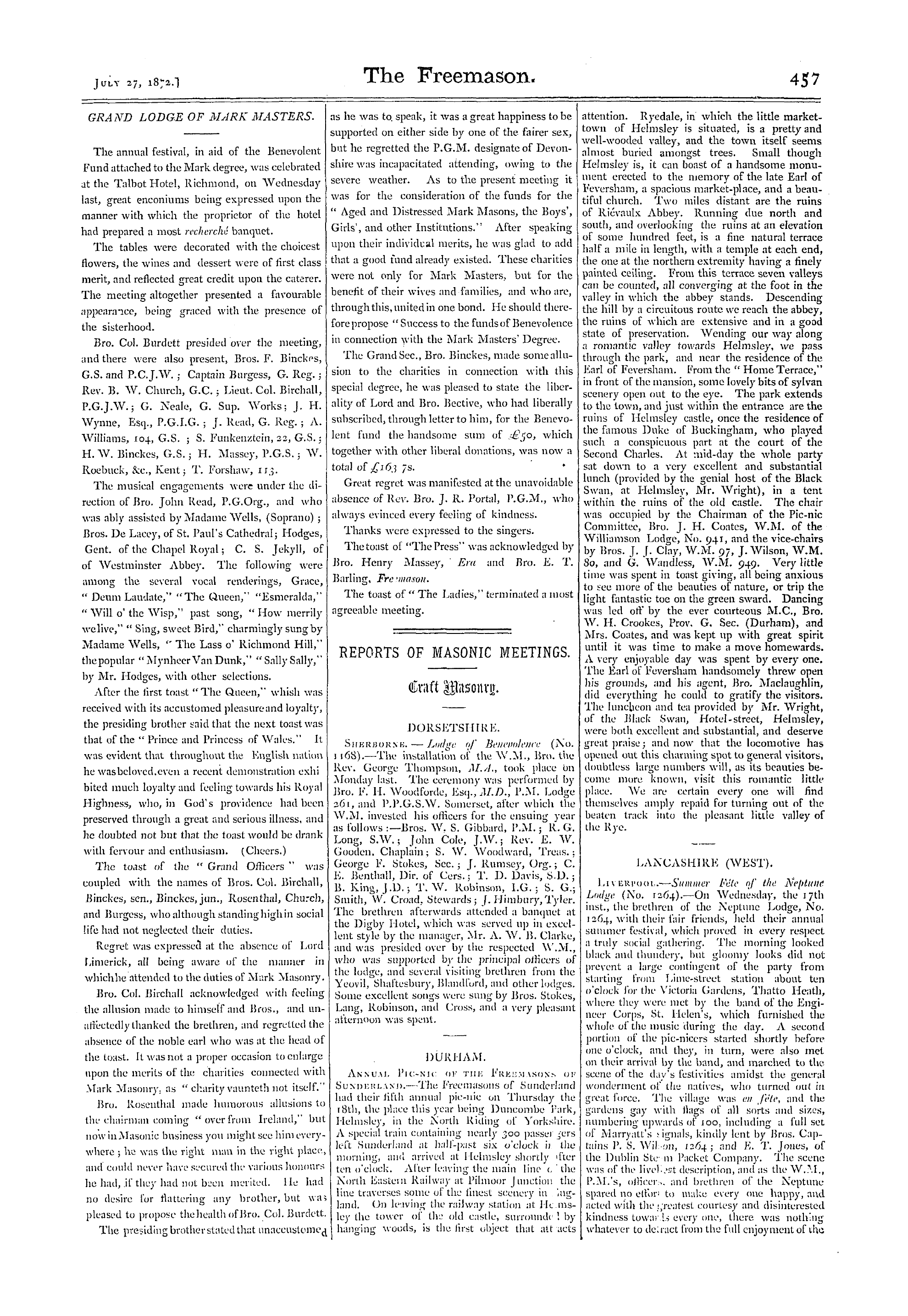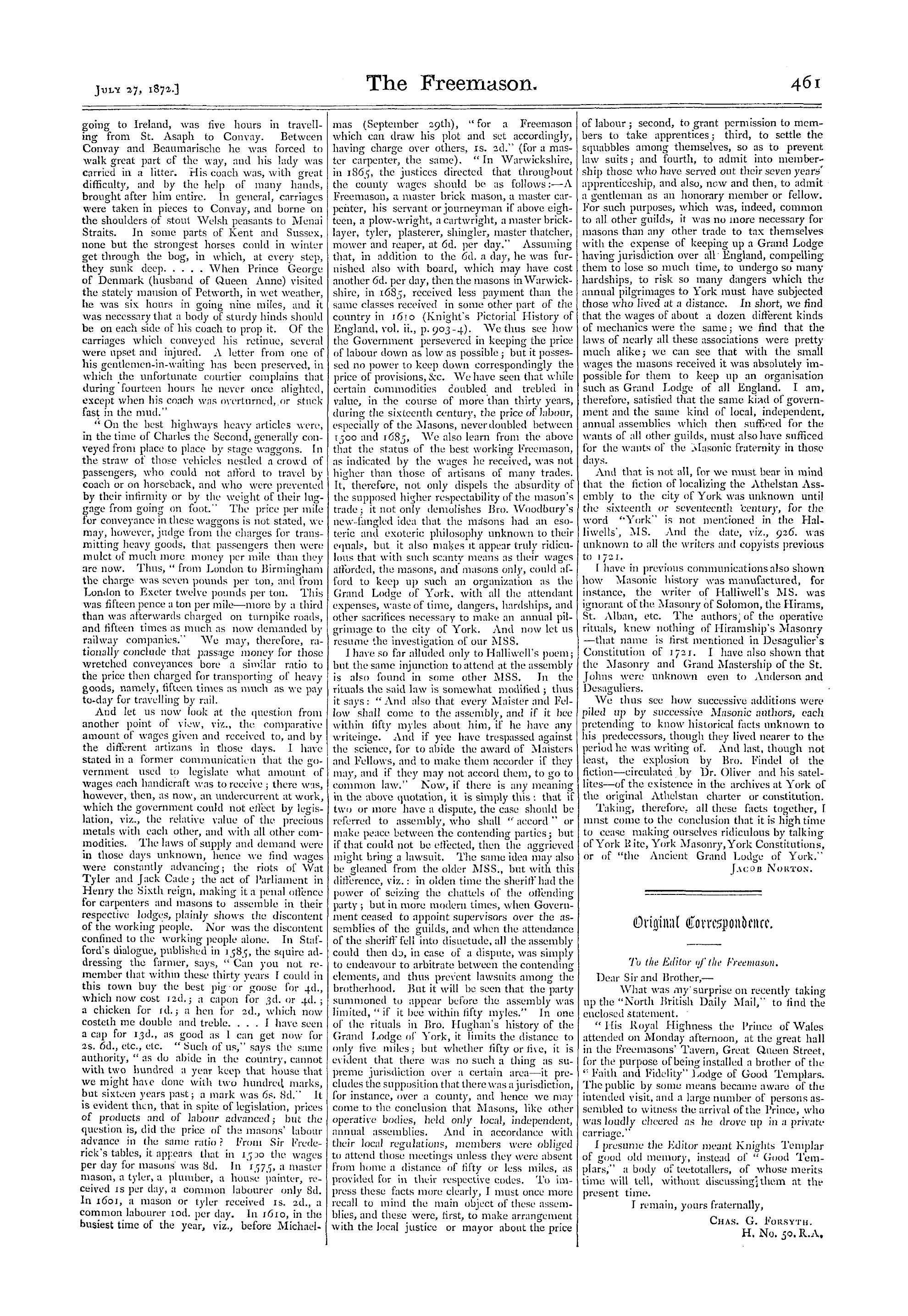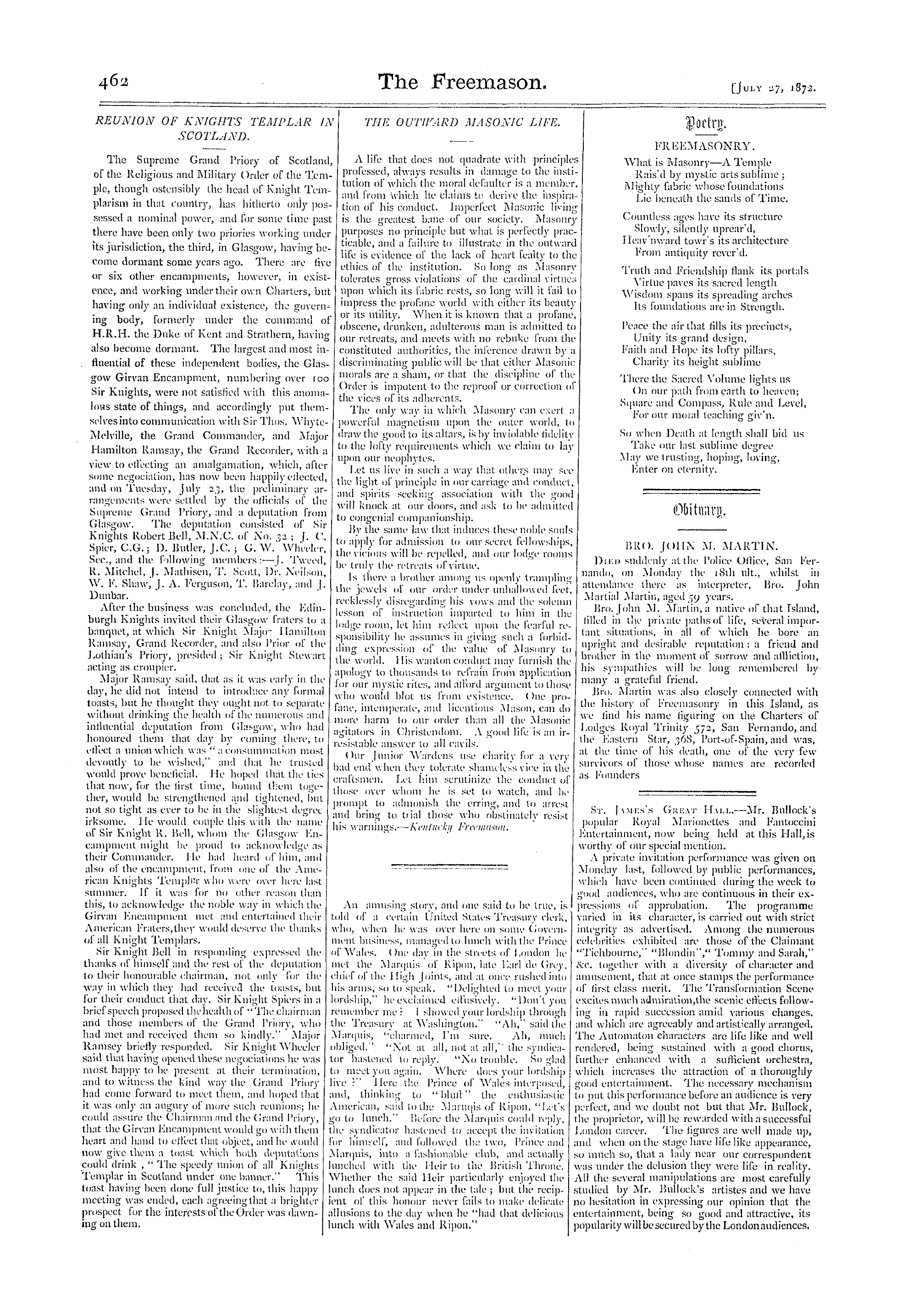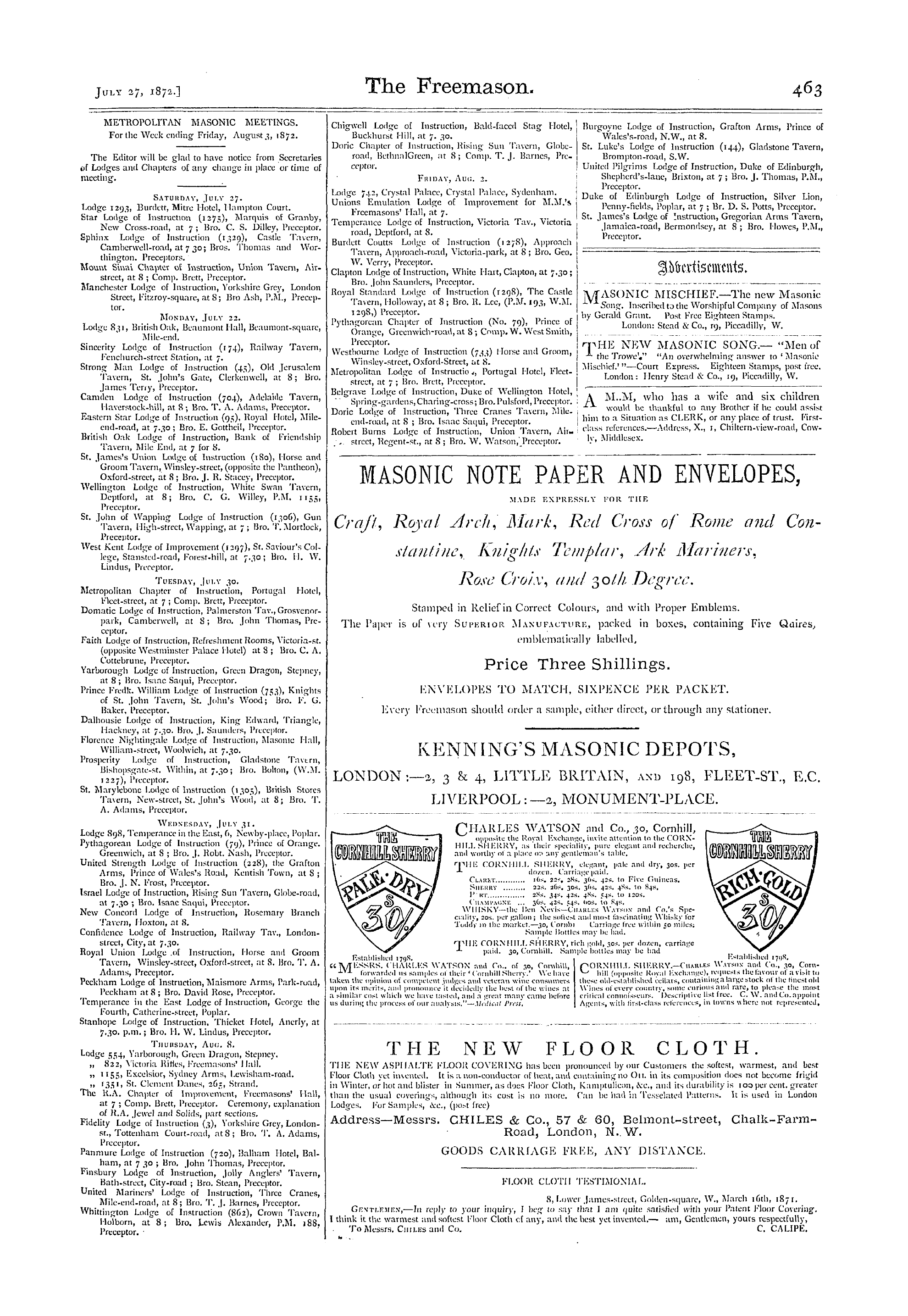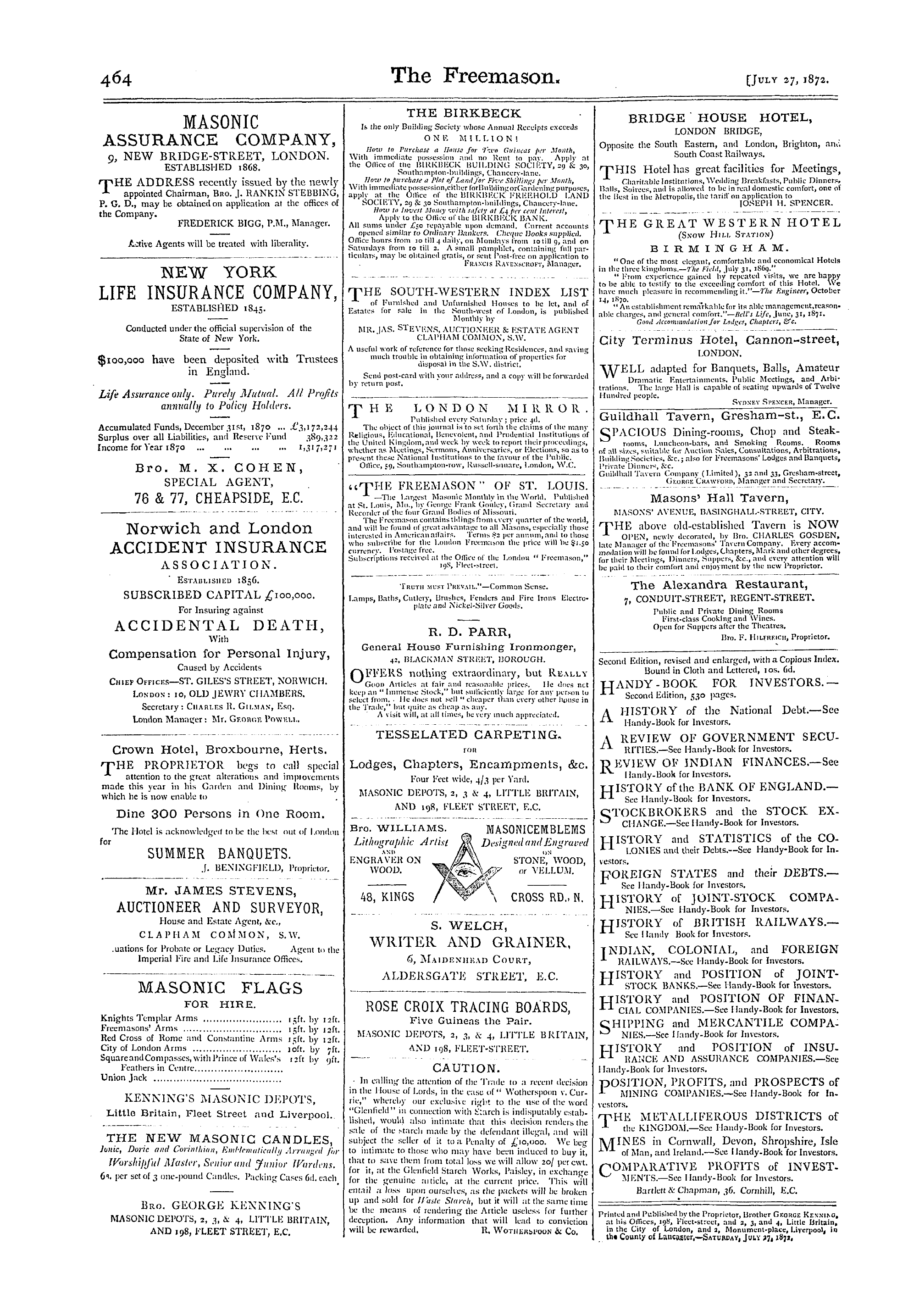-
Articles/Ads
Article Untitled Page 1 of 1 Article Untitled Page 1 of 1 Article Untitled Page 1 of 1 Article Untitled Page 1 of 1 Article AIDS TO STUDY. Page 1 of 1 Article AIDS TO STUDY. Page 1 of 1 Article AIDS TO STUDY. Page 1 of 1
Note: This text has been automatically extracted via Optical Character Recognition (OCR) software.
Ar00600
NOTICE . Tlie Subscription to THE FREEMASON is now i os . per annum , post-free , payable in advance . Vol . I ., bound in cloth 4 s . 6 d . Vol . If ., ditto 7 s . 6 d . Vol . HI ., ditto 1 . v - 0 < 1 - Vol . IV ., ditto 15 s . od . Reading Cases to hold 52 numbers ... 2 S . Cd . United States of America . THE FREEMASON is delivered free in any part of the United States for 12 s . per annum , payable in advance .
Ar00604
NOTICE TO SUBSCRIBERS . The Office of THE FREEMASON is now transferred lo 198 , FLEET-STREET , E . C . All communications for the Editor or Publisher should therefore be forwarded to that address .
Ar00605
flnsfocvs to CovTCspnbents . All communications for The Freemason should he written legibly mi one side of the paper only , and , it intended for insertion in the current number , must be received not later than 10 o'clock a . m . on Thursdays , unless in very special cases . The name and address of everv writer most he sent to us in confidence .
Ar00606
The Freemason , SATURDAY , J 27 , 1872 . The Freemason is published on Saturday Mornings in lime for the early trains . The price of the Freemason is Twopence per week ; annual subscription , IOS . fpayable in advance . ) All communication ' s , letters , & c , to be ad hessed to the Editor , 19 s ' , Fleet-street , E . C . Tlie Editor will p .-iycarefulattcntion to all MSS . entrusted tn him , but cannot undertake to return them unless accompanied by postage stamps .
Aids To Study.
AIDS TO STUDY .
Bv BRO . AVM . CARPKNTKR P . M . \ - P . Z . 71 ; XI . Of what is called the Old Assyrian Empire , we know , as I have already suggested , absolutely nothing . Fables we have , but these will not satisfy the enquiring mind . The accounts handed
down to us by Diodorus , lragus , Justin , Castor , Eusebius , and others , are so absurd and contradictory , that we cannot possibly give them our assent . This is easil y accounted for , as the whole of their information is known to have been
derived from Ctesias , who was noted as an arrant fabulist . AVho can believe that soon after the flood Ninus led to battle millions of men , that Semiramis , at the age of twenty , performed the
exploits he ascribes to her ; could employ two millions of men in building cities , and could procure three hundred thousand skins of black oxen , to dress her camels in the form of elephants ?
JJut these were mere trifles , for , as Strabo savs , nearly every great work in every part of Asia was ascribed to her ; her edifices found their limit only at the bounds of the habitable world , on the
frontiers of Scythia , and there it is said that Alexander saw her own record of her deeds "Nature gave me the form of a woman , but my deeds have equalled those of the bravest of men . I ruled the empire of Ninus , which , on the east ,
Aids To Study.
touches the river Hinaman ( Indus ) , on the south , the land of frankincense and myrrh ( Arabia Felix ) , on the north , the Sacae and the Sogdians . Before me no Assyrian beheld the seas . I looked
upon four so remote that none had reached them . I formed rivers to run where I wished , and I only wished it in p laces where they were useful . I made the barren soil fruitful , by watering it with
my rivers . I raised impregnable fortresess . I pierced roads with iron across impracticable rocks . My chariots have rolled in roads where the wild
beasts had formed no path . And in the midst of all my labours I found time for pleasure and for love . "
After having achieved all these wonders , and resigned the crown to her son Ninyas , she disappeared in the form of a dove , and was worshipped as a goddess . She thus maintained her place in the
Babylonian mythology ; for she was the daughter of the great goddess of Ascalon , Dercete , and became the wife of Oannes , who was the fishgod noticed in a former paper .
But apart from these absurd legends , the boundaries which Ctesias assigns to the Assyrian empire are incompatible with the extent of other nations at that period . In the time of Abraham
we find Chedolaomer and his three allies possessing distinct kingdoms on the frontiers of Assyria , without the least indication of dependence on that empire ( Gen . xiv . 1 ) , when ,
according to Ctesias , his country must have formed a part of it . In the days of the Judges we hear of a powerful kingdom in Mesopotamia , on the west of Assyria ( Judges iii . 8—11 ) .
It has to be added , that , so late as the time of David , the Hebrew monarchy extended its conquests over 3 great part of the country on the side of the Euphrates , and that Benhadad and
Hazard governed Syria as an independent State . As Sir Isaac Newton has observed ( " Chron . of Anc . Kingdoms , " ch . iii , ) the kingdom formed b y Nimrod , which was probably extended into
Assyria , was but of small extent , being only within the fertile plains of . Chaldea , Chalonitis , and Assyria , watered b y the Tigris and the Euphrates . After the days of Nimrod , we hear
no more of the Assyrian Empire till the days of Pul ( li . c . 790 ) . The four kings who invaded the southern coast of Canaan came from the
countries where Nimrod had reigned , and were probably some of his posterity , who had shared his conquests .
The Kingdoms of Israel , Moab , Amnion , Edom , Philistria , Zidon , Damascus , and Hamath the Great , continued , subject to other lords than the Assyrians , till the days of Pul and his
successors ; and so did the house of Eden ( Amos i ., 5 ; 3 Ki . xix , 12 ) , and HiMfln ( Gen . xii . j 2 Ki . xix . 12 ) , and SepharVaim in Mesopotamia , and Calneh , near Bagdad ( Gen . x . 10
Isa . x . 9 ; 2 Ki . xvii . 31 ) . AVhile thus adverting to the early history of Assyria and Bab ylon , and the myths and fables in which such writers as Ctesias have indulged , I
cannot help feeling the incomparable value of the sacred writings , as a record of history , independently of their containing a revelation of
Divine truth . As a record of historical facts , they purport to notice foreign states only so far as they are connected in any way with the history of the chosen people ; but these incidental
Aids To Study.
notices , even the briefest of them , are of infinite value to the student . They furnish a clue to many facts which could not have been understood without their assistance . They serve to
correct other historians , and in every instance in which the sacred writings and general history come into contact , they are to it what the chronometer is to the common watch—they measure
the same period , but with superior precision ; they relate the same events , but with greater accuracy . Still further , as the floating traditions of the heathen would bear upon the facts
recorded in the Scriptures ; so , by a reaction , sacred history clevelopes the hidden import of many an ancient institution , the intention of which was not comprehended by those who
lived under it , and which could not be otherwise understood . And it gives consistency and reality to the traditions of antiquity . It brings distant occurrences to bear upon each
other ; it discloses political interests , jarring among themselves , all tending to the harmony of the universe , and the amelioration of the human race . It supplies , in short , to time what
gravity is to space—the principle which holds and draws all things together . The proper home of the early Assyrians , then , as Smith observes , is marked by the four cities
which are connected with the name of Asshur , in the Book of Genesis—Nineveh , Rehoboth , Calah , and the " Great City " of Resen , between Nineveh and Calah . " ( Gen . x . 11 , 12 . )
Of these , Rehoboth is unknown , and is thought by some to have been , not a city , but as in the margin of our Bible , the " streets
of the city , " i . e ., of Nineveh . Calah is very probably identified with the large ruins of Nimrod , and Resen with those at Seamiyer ; but the certain identification of Nineveh with the
mounds opposite Mosul is enough to indicate the region , which , down to the latest period qf ancient history , preserved the name of Aturia ; the interchange of t with sh being very common
m those regions . Conversely , Tyrus is now Sur . Sir Isaac Newton and many others , who take the Scripture History as the onl y authentic one of these early times , ascribe the foundation of the
great monarchy of Assyria to Pnl or Phul , about twenty-four years before the ; era of Nabonassar , ' . 179 )' L'ars after the flood , and , according to Blair , 709 , or according to Newton , 790 .
Menahem having taken forcible possession of the throne of Israel , by . the murder of Shallum , ( 2 . Ki . xv . 10 . ) , was attacked by Pul , but prevented the hostilities meditated against him b y
presenting the invader with a thousand talents of silver . Pul , thus gratified , took the Kingdom of Israel under his protection , returned to his own
country , after having received voluntary homage from several nations in his march , as he had clone from Israel , and became the founder of the great
empire . As it was in the days of Pul that the Assyrians began to attack the inhabitants of Palestine . ( , 2 . Ki . xi . 9 , 1 . Chron . ' v . 26 ) , this was the time ,
according to Sir Isaac Newton , when the great Assyrian empire arose . Thus he interprets the words , •' since the time of the Kings of Assyria " ( Neh . is . 32 ); that is , since the time of the Kingdom of Assyria ; or since the rise of the . 'uipire .
Note: This text has been automatically extracted via Optical Character Recognition (OCR) software.
Ar00600
NOTICE . Tlie Subscription to THE FREEMASON is now i os . per annum , post-free , payable in advance . Vol . I ., bound in cloth 4 s . 6 d . Vol . If ., ditto 7 s . 6 d . Vol . HI ., ditto 1 . v - 0 < 1 - Vol . IV ., ditto 15 s . od . Reading Cases to hold 52 numbers ... 2 S . Cd . United States of America . THE FREEMASON is delivered free in any part of the United States for 12 s . per annum , payable in advance .
Ar00604
NOTICE TO SUBSCRIBERS . The Office of THE FREEMASON is now transferred lo 198 , FLEET-STREET , E . C . All communications for the Editor or Publisher should therefore be forwarded to that address .
Ar00605
flnsfocvs to CovTCspnbents . All communications for The Freemason should he written legibly mi one side of the paper only , and , it intended for insertion in the current number , must be received not later than 10 o'clock a . m . on Thursdays , unless in very special cases . The name and address of everv writer most he sent to us in confidence .
Ar00606
The Freemason , SATURDAY , J 27 , 1872 . The Freemason is published on Saturday Mornings in lime for the early trains . The price of the Freemason is Twopence per week ; annual subscription , IOS . fpayable in advance . ) All communication ' s , letters , & c , to be ad hessed to the Editor , 19 s ' , Fleet-street , E . C . Tlie Editor will p .-iycarefulattcntion to all MSS . entrusted tn him , but cannot undertake to return them unless accompanied by postage stamps .
Aids To Study.
AIDS TO STUDY .
Bv BRO . AVM . CARPKNTKR P . M . \ - P . Z . 71 ; XI . Of what is called the Old Assyrian Empire , we know , as I have already suggested , absolutely nothing . Fables we have , but these will not satisfy the enquiring mind . The accounts handed
down to us by Diodorus , lragus , Justin , Castor , Eusebius , and others , are so absurd and contradictory , that we cannot possibly give them our assent . This is easil y accounted for , as the whole of their information is known to have been
derived from Ctesias , who was noted as an arrant fabulist . AVho can believe that soon after the flood Ninus led to battle millions of men , that Semiramis , at the age of twenty , performed the
exploits he ascribes to her ; could employ two millions of men in building cities , and could procure three hundred thousand skins of black oxen , to dress her camels in the form of elephants ?
JJut these were mere trifles , for , as Strabo savs , nearly every great work in every part of Asia was ascribed to her ; her edifices found their limit only at the bounds of the habitable world , on the
frontiers of Scythia , and there it is said that Alexander saw her own record of her deeds "Nature gave me the form of a woman , but my deeds have equalled those of the bravest of men . I ruled the empire of Ninus , which , on the east ,
Aids To Study.
touches the river Hinaman ( Indus ) , on the south , the land of frankincense and myrrh ( Arabia Felix ) , on the north , the Sacae and the Sogdians . Before me no Assyrian beheld the seas . I looked
upon four so remote that none had reached them . I formed rivers to run where I wished , and I only wished it in p laces where they were useful . I made the barren soil fruitful , by watering it with
my rivers . I raised impregnable fortresess . I pierced roads with iron across impracticable rocks . My chariots have rolled in roads where the wild
beasts had formed no path . And in the midst of all my labours I found time for pleasure and for love . "
After having achieved all these wonders , and resigned the crown to her son Ninyas , she disappeared in the form of a dove , and was worshipped as a goddess . She thus maintained her place in the
Babylonian mythology ; for she was the daughter of the great goddess of Ascalon , Dercete , and became the wife of Oannes , who was the fishgod noticed in a former paper .
But apart from these absurd legends , the boundaries which Ctesias assigns to the Assyrian empire are incompatible with the extent of other nations at that period . In the time of Abraham
we find Chedolaomer and his three allies possessing distinct kingdoms on the frontiers of Assyria , without the least indication of dependence on that empire ( Gen . xiv . 1 ) , when ,
according to Ctesias , his country must have formed a part of it . In the days of the Judges we hear of a powerful kingdom in Mesopotamia , on the west of Assyria ( Judges iii . 8—11 ) .
It has to be added , that , so late as the time of David , the Hebrew monarchy extended its conquests over 3 great part of the country on the side of the Euphrates , and that Benhadad and
Hazard governed Syria as an independent State . As Sir Isaac Newton has observed ( " Chron . of Anc . Kingdoms , " ch . iii , ) the kingdom formed b y Nimrod , which was probably extended into
Assyria , was but of small extent , being only within the fertile plains of . Chaldea , Chalonitis , and Assyria , watered b y the Tigris and the Euphrates . After the days of Nimrod , we hear
no more of the Assyrian Empire till the days of Pul ( li . c . 790 ) . The four kings who invaded the southern coast of Canaan came from the
countries where Nimrod had reigned , and were probably some of his posterity , who had shared his conquests .
The Kingdoms of Israel , Moab , Amnion , Edom , Philistria , Zidon , Damascus , and Hamath the Great , continued , subject to other lords than the Assyrians , till the days of Pul and his
successors ; and so did the house of Eden ( Amos i ., 5 ; 3 Ki . xix , 12 ) , and HiMfln ( Gen . xii . j 2 Ki . xix . 12 ) , and SepharVaim in Mesopotamia , and Calneh , near Bagdad ( Gen . x . 10
Isa . x . 9 ; 2 Ki . xvii . 31 ) . AVhile thus adverting to the early history of Assyria and Bab ylon , and the myths and fables in which such writers as Ctesias have indulged , I
cannot help feeling the incomparable value of the sacred writings , as a record of history , independently of their containing a revelation of
Divine truth . As a record of historical facts , they purport to notice foreign states only so far as they are connected in any way with the history of the chosen people ; but these incidental
Aids To Study.
notices , even the briefest of them , are of infinite value to the student . They furnish a clue to many facts which could not have been understood without their assistance . They serve to
correct other historians , and in every instance in which the sacred writings and general history come into contact , they are to it what the chronometer is to the common watch—they measure
the same period , but with superior precision ; they relate the same events , but with greater accuracy . Still further , as the floating traditions of the heathen would bear upon the facts
recorded in the Scriptures ; so , by a reaction , sacred history clevelopes the hidden import of many an ancient institution , the intention of which was not comprehended by those who
lived under it , and which could not be otherwise understood . And it gives consistency and reality to the traditions of antiquity . It brings distant occurrences to bear upon each
other ; it discloses political interests , jarring among themselves , all tending to the harmony of the universe , and the amelioration of the human race . It supplies , in short , to time what
gravity is to space—the principle which holds and draws all things together . The proper home of the early Assyrians , then , as Smith observes , is marked by the four cities
which are connected with the name of Asshur , in the Book of Genesis—Nineveh , Rehoboth , Calah , and the " Great City " of Resen , between Nineveh and Calah . " ( Gen . x . 11 , 12 . )
Of these , Rehoboth is unknown , and is thought by some to have been , not a city , but as in the margin of our Bible , the " streets
of the city , " i . e ., of Nineveh . Calah is very probably identified with the large ruins of Nimrod , and Resen with those at Seamiyer ; but the certain identification of Nineveh with the
mounds opposite Mosul is enough to indicate the region , which , down to the latest period qf ancient history , preserved the name of Aturia ; the interchange of t with sh being very common
m those regions . Conversely , Tyrus is now Sur . Sir Isaac Newton and many others , who take the Scripture History as the onl y authentic one of these early times , ascribe the foundation of the
great monarchy of Assyria to Pnl or Phul , about twenty-four years before the ; era of Nabonassar , ' . 179 )' L'ars after the flood , and , according to Blair , 709 , or according to Newton , 790 .
Menahem having taken forcible possession of the throne of Israel , by . the murder of Shallum , ( 2 . Ki . xv . 10 . ) , was attacked by Pul , but prevented the hostilities meditated against him b y
presenting the invader with a thousand talents of silver . Pul , thus gratified , took the Kingdom of Israel under his protection , returned to his own
country , after having received voluntary homage from several nations in his march , as he had clone from Israel , and became the founder of the great
empire . As it was in the days of Pul that the Assyrians began to attack the inhabitants of Palestine . ( , 2 . Ki . xi . 9 , 1 . Chron . ' v . 26 ) , this was the time ,
according to Sir Isaac Newton , when the great Assyrian empire arose . Thus he interprets the words , •' since the time of the Kings of Assyria " ( Neh . is . 32 ); that is , since the time of the Kingdom of Assyria ; or since the rise of the . 'uipire .






